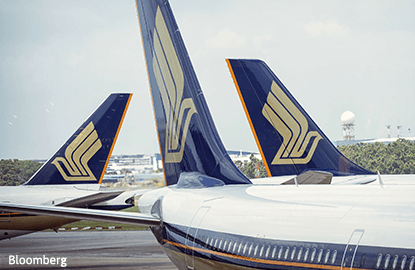
SINGAPORE (Feb 8): Singapore Airlines’ core earnings for 3Q17 rose 12% y-o-y to S$256 million, after excluding a S$79 million impairment charge on the value of the Tigerair brand arising from the merger between Tigerair and Scoot.
The results were boosted by the outstanding performance at SIA Cargo, where operating profits rose by S$50 million to S$53 million during the quarter, on the back of higher air freight demand between Asia and Europe and on the transpacific routes. In fact, UOB Kay Hian pointed out that this was the cargo operations’ highest quarterly earnings in nine years.
However, at least four brokerages — UOB Kay Hian, DBS Vickers Securities, Maybank Kim Eng, and CIMB Securities — are maintaining their “neutral” stance on SIA with Morgan Stanley maintaining an underweight rating with a price target of S$8.96. UBS has a “buy” rating with a target price of S$9.81.
Why is this so?
CIMB’s analyst Raymond Yap points out that the increase in air freight demand coincided with an increase in ocean freight demand and could be due to the restocking for the early Lunar New Year in 2017. That demand, Yap said, may not last.
On the other hand, Mohshin Aziz, analyst at Maybank Kim Eng, noted that SIA Cargo’s earnings jump merely masked over the underlying weakness in the airline’s overall business where passenger yields had fallen in all of its business segments.
“Yields were distinctively weak owing to intense competition and overcapacity, [and] costs were in order thanks to lower fuel hedging losses and productivity gains,” says Aziz, adding that SIA’s nine-month core earnings of S$457 million achieved just 69% of its full year estimates.
Maybank Kim Eng has a price target of S$9.70 for SIA.
DBS Group Research’s analyst Paul Yong agreed, and is forecasting sluggish growth in operating profits over the coming quarters amid the weak demand environment and higher non-fuel related expenses.
“While SIA has enjoyed lower fuel costs in the last few quarters, lower revenue as a result of lower yields (for both the core SIA passenger and cargo segments) and higher non-fuel costs such as maintenance, repair and overhaul (MRO) and staff costs have eaten into these savings,” explains Yong in a note on Wednesday. DBS has a price target of S$10.10 for the stock.
In fact, CIMB’s Yap believes the low-cost carrier business is not without its own set of troubles. “Scoot has delivered stronger y-o-y earnings for at least the past two years, as the delivery of its B787s led to aggressive cost-efficient expansion, coinciding with low oil prices and the decommissioning of aged 777-200s,” he says in his note on Wednesday.
“However, for the first time ever, Scoot’s 3Q revenue per available seat km (RASK) fell by more than its cost per available seat km (CASK), burdened as it were by 50% y-o-y available seat km (ASK) expansion over the past four quarters, by promotional fares necessitated by its recent entry into India and by the negative impact of demonetisation in India.”
Yap concedes SIA has continued to invest in its longer term business, by refurbishing its lounges, installing premium economy seats on all of its 777-300ER planes, and launching a new premium product for five of its A380s that will be delivered over the next two years. The group is also expected to relaunch direct flights to the US and complete the brand merger between Scoot and Tigerair within the year.
However, Yap continues to be pessimistic about the airline’s fortunes. “These far-sighted initiatives keep SIA competitive against its peers, but the road ahead is tough. Only a major global recovery can lift earnings from current depressed levels.” CIMB has a price target of S$10.50 for SIA.
Furthermore, UOB Kay Hian’s K Ajith noted that the group has entered into a longer-dated Brent hedge, hedging 33% to 39% of its fuel requirements at between US$53 to US$59 per barrel until 2022. “These are attractive levels but will likely result in substantial forward commitments, which could affect dividend payout,” says Ajith who has a target of S$10.10.
The key lies in the growing competition in the long haul market and the budget consciousness of its customers, according to Maybank’s Aziz.
“SIA’s misfortunes are due to market overcrowding on its key markets. This is structural in nature and despite management’s best efforts; they don’t seem to have an answer for it. It is very likely that the current mid single-digit net profit margins and return on equity is what SIA could hope for in the future. That said, it’s best to avoid SIA for other airlines with superior financial returns,” he concludes.
Shares in SIA are trading at S$9.91 on Wednesday.